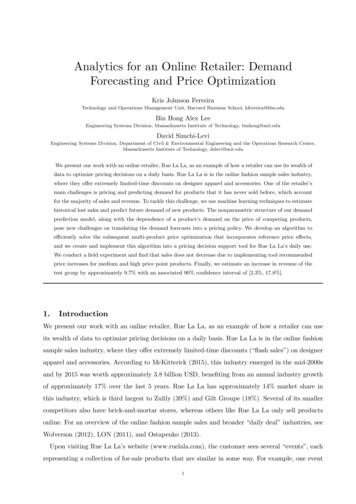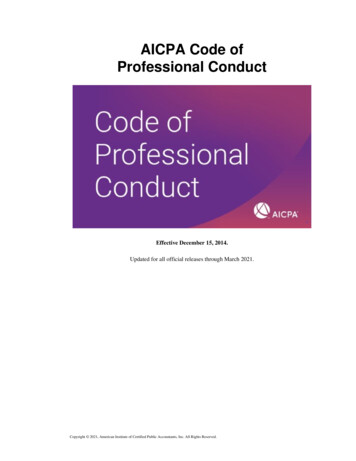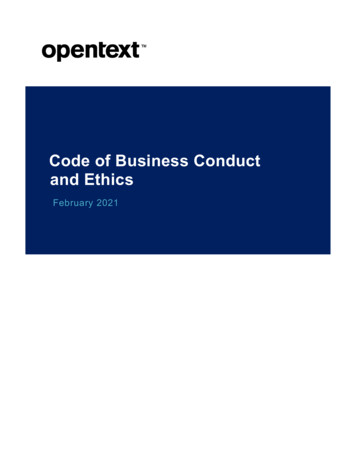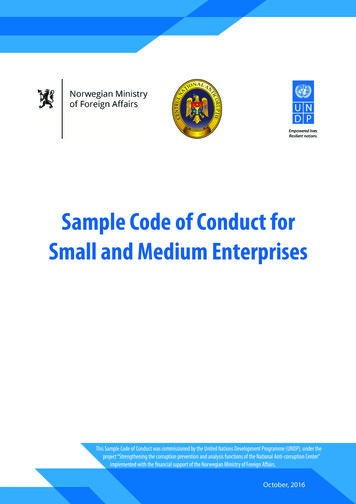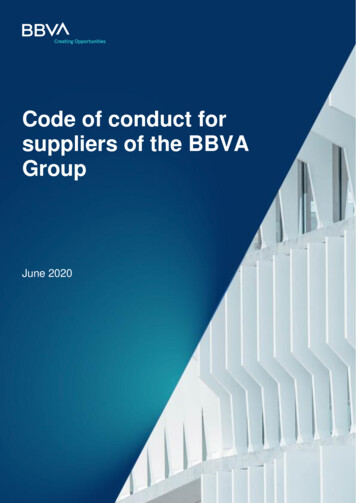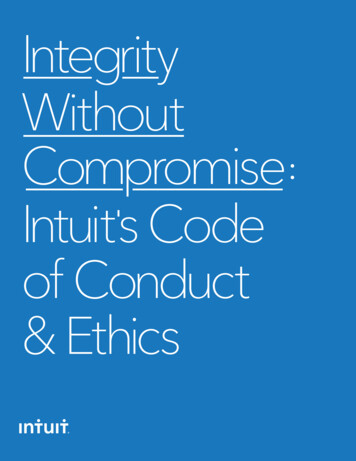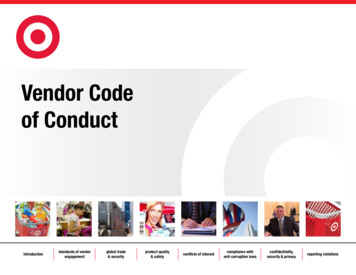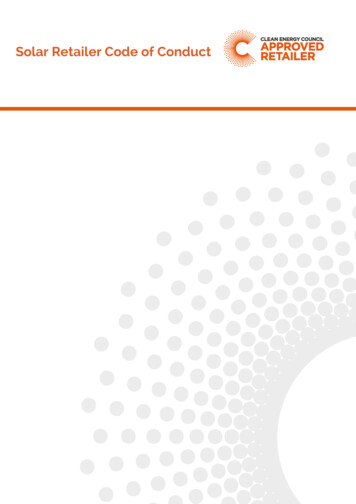
Transcription
Solar Retailer Code of ConductCLEAN ENERGY COUNCIL – SOLAR RETAILER CODE OF CONDUCTOCTOBER 20151
TABLE OF CONTENTS1.INTRODUCTION. 41.1 Purpose and Objectives . 4CEC Accreditation for Solar PV Designers/Installers . 4Solar Retailer Code of Conduct . 51.2 Scope and Interpretation . 61.3 Signatories to the Code. 72.GENERAL RULES AND STANDARDS . 82.1 Pre-Sale Activities . 8Advertisements and promotions. 8Sales and quoting practices . 9Point of contract . 10Prior to signing the contract . 12Approval to connect to the electricity grid . 122.2 Post-Sale Activities . 15Pre-installation . 15Post-installation. 162.3 Documentation . 192.4 General Business and Obligations of Signatories. 20Compliance with the law . 20In-house procedures and complaints handling . 20Information to be provided to the Code Administrator. 21Training and promotion of the Code . 23Obligations of Signatories and grounds for action to be taken. 233.CODE ADMINISTRATION AND COMPLIANCE . 253.1 Role of Clean Energy Council (Code Administrator) . 253.2 Role of the Code Review Panel . 26CLEAN ENERGY COUNCIL – SOLAR RETAILER CODE OF CONDUCTOCTOBER 20152
3.3 Consumer Disputes . 273.4 Compliance and Auditing . 273.5 Breaches of the Code . 28Breach matrix . 293.6 Sanctions . 32Termination of Signatories . 333.7 Appeals. 333.8 Review of the Code and Public Reporting . 344.BECOMING A CODE SIGNATORY . 354.1 Application Process . 354.2 Code Fees . 364.3 Withdrawing from the Code . 374.4 Use of Brand Mark . 375.APPENDIX . 385.1 Glossary and Definitions . 385.2 Additional Information. 40Designer/Installer Accreditation . 40The Code . 40Consumer Information . 405.3 Consumer Protection Organisations/Other Contacts . 40Consumer Affairs . 40Other Bodies . 415.4 Relevant Acts and Legislation . 42CLEAN ENERGY COUNCIL – SOLAR RETAILER CODE OF CONDUCTOCTOBER 20153
1. INTRODUCTIONThe Clean Energy Council (CEC) is the peak body representing Australia’s renewableenergy and energy efficiency industry.1.1 Purpose and ObjectivesThis non-prescribed voluntary code of conduct (the Code) aims to promote best practicemeasures and activities for retail businesses selling solar photovoltaic (PV) systems. ThisCode is for retail businesses that want to demonstrate the commitment they have topromoting responsible activity and development in the renewable energy sector acrossAustralia. This Code is not intended to replace existing consumer, energy or environmentalplanning legislation, policy or regulations at local, state or federal government levels, but tobring about increased accountability within the PV retail industry.The primary entities involved in the sale and installation of PV are the installer, designer, andretailer. It is the nature of the PV market that these roles can all be filled by one individual, orconversely, by two or three different entities. The former category is typically found in smallretail businesses run by a qualified installer/designer, and the latter typically in medium- tolarger-sized companies that subcontract out the designs and/or installations of PV systems,meaning that those running the business or making a sale are less likely to be qualifiedinstallers/designers. Many PV retailers in the industry now sell systems direct to consumersand sub-contract the installation of those systems.CEC Accreditation for Solar PV Designers/InstallersThe CEC Accreditation Team manages a PV accreditation program to accredit the designersand installers of solar systems. CEC Accreditation is not linked to membership with the CEC.This qualification demonstrates competence in design and/or installation of stand-aloneand/or grid-connected solar PV systems. Under the PV accreditation scheme, which has atechnical focus on safety and the correct design and installation of PV systems, onlyindividuals are able to attain accreditation. A CEC-accredited solar designer/installer: has completed the necessary solar specific training courses;is bound by the CEC Accreditation Code of Conduct and the CEC Accreditation Termsand Conditions;complies with the CEC Design and Install Guidelines, relevant Australian Standards andall other relevant regulations when designing/installing PV systems.In order to claim federal government financial incentives available under the Small-scaleRenewable Energy Scheme (SRES), consumers must use a CEC-accredited installer anddesigner, in accordance with the Renewable Energy (Electricity) (Cth) Regulations 2001.More information on the Solar PV Accreditation Program is available at:solaraccreditation.com.au.CLEAN ENERGY COUNCIL – SOLAR RETAILER CODE OF CONDUCTOCTOBER 20154
Solar Retailer Code of ConductAs discussed above, the CEC Accreditation Program deals with matters relating to theinstallation and design of PV systems. This Code deals with matters relating to the marketingand sale of PV systems to ensure PV retailers also maintain a standard that will benefitconsumers and the industry.The Code has been developed to improve the relationship between consumers and PVretailers and to ensure the industry is suitably regulated. The Code is a self-regulatedscheme designed to provide consumers with confidence that solar retailers will act incompliance with (and where appropriate, go beyond) relevant federal and state laws andregulations, and conduct their business in a professional and ethical manner. The Code alsodeliberately connects the responsibility of the retailer with the obligations of accreditedinstallers/designers, to ensure that retailers are fully accountable for the actions of anysubcontracted parties. This Code aims to address identified issues that may impact on thereputation of the solar industry. These issues include: Misleading claims given to consumers regarding the performance of their PV system andfuture electricity bills. Misleading advertising regarding the size of PV systems, the value of availablegovernment incentives, and the suitability of the PV system. The retailer not taking responsibility for the whole of the PV system including productwarranties and workmanship. Sub-standard installation work. The retailer not taking responsibility for subcontracted parties acting on their behalf andany parties who generate sales leads utilised by the retailer.The Code will be updated to reflect changes in the above, with the aim of proactivelyaddressing issues that adversely affect consumers and the reputation of the PV industry.To achieve its objectives, this Code addresses four broad subject areas:1.2.Pre-Sale activities To protect the consumer against dishonest or misleading advertising and salestactics, and to ensure that sales representatives act ethically at all times duringmarketing campaigns and when dealing with consumers. To ensure that the consumer is provided with the necessary written information toenable full understanding and awareness of their purchase.Post-Sale activities To ensure that consumers’ legal rights relating to cooling-off periods, deposits andrefunds are respected, and that that the consumer has the opportunity to cancel acontract where changes are made after point of contract that are not approved inwriting.CLEAN ENERGY COUNCIL – SOLAR RETAILER CODE OF CONDUCTOCTOBER 20155
3. To ensure that the consumer receives a system that is installed correctly, inaccordance with existing legislation, regulations, standards and guidelines. To ensure that the consumer is provided with a standard minimum warranty periodcovering the operation and performance of the entire system, and that the retailer isresponsible for addressing any problems relating to workmanship or product thatarise during this period.Documentation 4.To ensure that the consumer is provided with the required documentation after thePV system is installed, and that the retailer and the consumer are fully aware of whois responsible for the provision of the relevant documentation.General business To ensure that the retailer adheres to all existing legislation and regulations, andmaintains consistent business practices including, but not limited to, effectivecomplaint handling procedures and cancellation procedures.1.2 Scope and InterpretationWhile the Code has been developed primarily to address issues arising during the sale andinstallation of small-scale PV to residential and small business consumers, the Code appliesto any PV retailer that becomes a Signatory, regardless of what size system and to whomthey are selling. However, where signatories are selling PV to medium- and large-scalebusiness consumers (who can be assumed to have a genuine and reasonable opportunity tonegotiate the terms of a contract), it is acceptable for a commercial contract to supersedespecific clauses of the Code.This Code co-exists with relevant state or federal legislation, including Australian ConsumerLaw (Cth) (ACL) (Schedule 2 of the Competition and Consumer Act 2010), which replacedthe Trade Practices Act 1974. Signatories’ obligations under these laws are not replaced orrestricted by this Code. This Code applies to the extent that it is consistent with all existingstate and federal legislation and regulation. Where the Code is found to be inconsistent withany existing state or federal legislation or regulation, that regulatory obligation will takeprecedence to the extent of the inconsistency. Compliance with this Code does notguarantee compliance with any legislation.A summary of relevant laws that protect consumers is provided at Appendix 5.4.CLEAN ENERGY COUNCIL – SOLAR RETAILER CODE OF CONDUCTOCTOBER 20156
1.3 Signatories to the CodeSolar PV retail businesses that are signatory parties to this Code are compliant with andagree to adhere to the Code. They: are PV retailers, including those selling PV to residential and small business consumersand those selling PV to medium and large-scale business consumers; are committed to developing and conducting their business in line with best industrypractices and interacting with consumers in a professional and ethical manner; and include non-CEC members and CEC members who apply and are accepted assignatories to this Code.A regularly updated list of current signatories to the Code is available online for consumersat olar-retailers.CLEAN ENERGY COUNCIL – SOLAR RETAILER CODE OF CONDUCTOCTOBER 20157
2. GENERAL RULES AND STANDARDSSignatories to the Code comply with the rules and standards in this section as set out below.2.1 Pre-Sale ActivitiesAdvertisements and promotions2.1.1 Any advertisements, promotions, quotations and statements produced must be legal,truthful, and comply with all relevant legislation. Signatories must:(a) ensure all state and federal government incentive schemes are honestly andaccurately represented, including not misrepresenting an association withgovernment, or falsely claiming to be part of a government scheme;(b) not provide any false or misleading claims relating to the company, product orservices being offered including system performance, stocks and substitution ofproducts;(c) clearly attribute any claims relating to performance and savings to a reputablesource;(d) advertise the total price as prominently as they advertise a component of theprice;(e) provide information that is specific to the state or region of advertisement; and(f) not engage in any misleading or deceptive conduct in relation to the price, valueor quality of goods or services including:(i)failing to clearly outline disclaimers or relying on disclaimers buried in smallprint in order to deliberately mislead a consumer;(ii) making statements with promises, predictions or opinions that are known tobe untrue or incorrect, or for which there are no reasonable grounds to makethem;(iii) quoting tariffs or financial incentives that are no longer available or notavailable in the region of advertisement;(iv) misleading consumers about the impact that installing solar will have on theirelectricity bills;(v) misleading consumers in relation to the size of the system or output;(vi) advertising large inverters with small systems, with the intention of making itappear that the system size is the size of the advertised inverter;(vii) the place of origin (manufacture) of a product; andCLEAN ENERGY COUNCIL – SOLAR RETAILER CODE OF CONDUCTOCTOBER 20158
(viii) exaggerating or misleading a consumer in regards to their need for theproduct.(ix) making representations regarding the cost of finance or an alternativepurchasing arrangement for the product, such as representing that there isno additional cost for the finance or alternative purchasing arrangementwhen the price of the product has been inflated above the cash price ormarket value of the product.Sales and quoting practices2.1.2 Signatories must adhere to ethical sales and quoting practices during all steps of theprocess, including but not limited to:(a) avoiding high-pressure sales tactics that induce consumers to make hasty oruninformed decisions about the product and technologies they are selecting.High-pressure sales tactics can be defined as (for example):(i)seeking to sell products to individuals who, or organisations that, areclearly unable to understand the information and/or the contract they arebeing asked to enter into. For example, deliberately targeting consumerswho are vulnerable due to mental illness or physical disability, age,learning difficulties, or speaking English as a second language;(ii)offering inflated prices and then discounts for agreeing to sign on the dayor for providing testimonials and/or providing referrals;(iii)revisiting the consumer’s premises uninvited intending to pressure theconsumer;(iv)applying psychological pressure (by appealing to the consumer’s fears,greed or vanity), to persuade the consumer to make a quick purchasedecision;(v)employing badgering techniques, such as making frequent telephone calls,to pressure individuals or organisations into signing contracts; and(vi)if the consumer reasonably feels they have been subject to high-pressuresales tactics then this may also be considered to constitute such tactics. What constitutes ‘reasonable’ will be determined by the CodeAdministrator (see section 3.1 below).(b) When engaging the consumer in their home or place of business:(i)identifying all sales agents with company-issued identification for the safetyand comfort of consumers;(ii)explaining up-front the purpose of the visit and informing the consumer thatthey can ask the retailer to leave at any time;(iii) leaving the premises immediately if the consumer asks them to do so; and(iv) explaining to consumers their right to terminate the agreement within tenbusiness days for unsolicited sales.CLEAN ENERGY COUNCIL – SOLAR RETAILER CODE OF CONDUCTOCTOBER 20159
2.1.3 Any reference to Small-scale Technology Certificates (STCs) must be consistent withClean Energy Regulator wording, whereby an STC is a financial incentive, not arebate, and consumers will not qualify for any government-based financialrecompense at the completion of the STC creation process.2.1.4 Consumers must be given a flyer describing this Code and also including:(a) the process for provision of consumer feedback and lodging consumercomplaints;(b) a link to the CEC Solar PV Consumer Guide.2.1.5 An electronic link to this flyer is acceptable only if a hard copy can be provided uponrequest. The Code flyer will be produced and provided to signatories by the CodeAdministrator (see section 3.1).Point of contract2.1.6 A written contract must be provided to the consumer that shows:(a) an itemised list of the goods to be supplied;(b) the total price of all goods and services;(c) the total value of any discounts, STCs, Goods and Services Tax (GST) andrebates as applicable;(d) full specifications of the system, including the manufacturer, model, quantity andpower rating of the solar modules and the inverter/s;(e) a site-specific full system design including the proposed roof plan (sketch ordiagram is acceptable), orientation and tilt, expected efficiency losses due toshading, and the system’s site-specific estimated energy yield, i.e. average dailyperformance estimate in kilowatt hours (kWh) for each month of solar generation. The performance estimate must be based on data obtained from theCEC System Design Guidelines for Accredited Designers or otherreputable source.It is acceptable for this section 2.1.6(e) to be provided as a deliverable of thecontract, provided that:(i)this information is provided before the expiry of any cooling-off period; and(ii) where section 2.1.6(e) is provided as a deliverable of contract:1.the initial contract must include a generic outline of the likely systemperformance estimate (to enable the consumer to make an informedpurchase decision); and2.the consumer must be entitled to a full refund upon request, if they donot consent to the site-specific full system design and performanceestimate upon receipt of this information.CLEAN ENERGY COUNCIL – SOLAR RETAILER CODE OF CONDUCTOCTOBER 201510
(f) Any site conditions and special circumstances beyond the control of theSignatory which may result in extra chargeable work not covered by the quote.This includes any additional costs that may arise at or after installation and thatwill not be borne by the Signatory. For example, fees for meterexchange/reconfiguration, damage on meter panels, and changing dedicated offpeak control devices if required;(g) an estimated timetable for supplying and installing the system. Where timeframesare out of control of the retailer, this can be noted with relevant disclaimers;(h) business terms, including the payment method, deposits and timetable, and howlong the quote will be valid for;(i) details about any after-sales services, guarantees and express warranties. Thewarranty must:(i) Include a statement that the consumer’s rights under the warranty sitalongside the consumer guarantees which are required under ACL andcannot be excluded. Under ACL, consumers cannot sign away their consumerguarantee rights. Signatories must not put terms into theircontracts to avoid their consumer guarantee obligations.(ii) The consumer’s cooling-off and termination rights.(j) Full disclosure of all assumptions made in relation to systems and financeofferings including:(i) system design, performance and output assumptions;(ii) financial savings including STC financial incentives, savings relating toreturn on investment, income and energy prices; and(k) a clause stating that the Signatory must comply with this Code.2.1.7 The contract must be expressed in a clear and transparent way, using plain languagethat is legible.2.1.8 Signatories must endeavour to draw to the attention of the consumer specificrequirements of the contract which, if not brought to the consumer’s attention, arelikely to result in a dispute. For example, section 2.1.6(g), additional fees that mayarise, or if there is any difference between a price verbally quoted, and the finalcontract price.2.1.9 Both parties must sign the agreement and any amendments. Equivalent methods oflegal agreement other than signing a contract in person are also permitted (forexample, electronic acceptance).2.1.10 Any requirement to provide a document or information in writing can be met inelectronic form, or to provide a signature can be met in electronic or verbal form.2.1.11 Receipts must be issued for all deposits collected.CLEAN ENERGY COUNCIL – SOLAR RETAILER CODE OF CONDUCTOCTOBER 201511
Prior to signing the contract2.1.12 Before the contract is signed the Signatory must provide the consumer with theaddress of the local office or showroom, or a telephone number where any queriescan be answered.2.1.13 Signatories must ensure that the contract is explained to consumers prior to enteringinto an agreement.2.1.14 Signatories must clearly explain the process surrounding the payment and trade ofSTCs, including where relevant, the provision of accurate information about theoperation of the STC Clearing House (i.e. that STCs in the Clearing House are onlysold when there is a buyer, there is no guarantee on how long they will take to sell,and consumers are not guaranteed 40).2.1.15 Signatories must advise consumers that their electricity contract/tariff may changefollowing installation of solar and that the consumer should contact their electricityretailer:(a) before signing a contract, to check what new electricity tariff rates may beapplied; and(b) after installation of the solar PV system, to confirm that the agreed tariff has beenapplied.Approval to connect to the electricity grid2.1.16 Signatories must inform consumers (where relevant in the state of installation),before a contract is signed, that:(a) the consumer requires approval from their distributor to connect a solar PVsystem to the electricity grid (“grid connection approval”); and(b) the relevant paperwork must be completed and submitted prior to installation.2.1.17 Where Signatories have fulfilled their obligations under 2.1.16 above and theconsumer takes responsibility for obtaining grid connection approval and(a) the application is rejected and(b) the contract has already been signed,the consumer is entitled to the return of all moneys paid minus reasonable expensesincurred by the Signatory to the point of termination of the contract.2.1.18 Where a Signatory has fulfilled its obligations under 2.1.16 above and the consumerauthorises the Signatory to obtain grid connection approval on its behalf, theSignatory must ensure the consumer receives approval prior to installation.2.1.19 Where a Signatory has fulfilled its obligations under 2.1.16 above and the consumerauthorises the Signatory to prepare and submit the documentation required for gridconnection approval andCLEAN ENERGY COUNCIL – SOLAR RETAILER CODE OF CONDUCTOCTOBER 201512
(a) the application is rejected and(b) the contract has already been signed,the consumer is entitled to a full refund.Finance and alternative purchasing arrangements2.1.20 When advertising an arrangement that provides an alternative to initial outrightpurchase (for example, a credit contract or a lease or power purchase agreement),the Signatory must comply with section 2.1 (and all other sections) of this Code.2.1.21 The Code does not provide an exhaustive list of the notification obligations whichapply to credit providers. Credit providers are required to meet obligations imposedby section 21C of the Privacy Act 1988 (Cth) and clause 4.1 of the Credit ReportingPrivacy Code.2.1.22 When offering to a consumer, whether through the Signatory’s own or associatedcompany or via a third party provider, an arrangement that provides an alternative toinitial outright purchase, a Signatory must ensure that the consumer clearly andaccurately receives the following information:(a) the name of the provider to whom the consumer will be contracted;(b) a clear statement regarding the nature of the arrangement being entered into(e.g. whether it involves a credit contract or other financial product within themeaning of the Australian Securities and Investments Commission Act or a nonregulated credit arrangement);(c) a clear statement that the periodic payments are available only if the consumerwishes to take advantage of the finance or alternative purchasing arrangement;(d) the comparative cost of that same product if the consumer was to purchase itoutright on that day;(e) a clear statement that fees and charges apply in relation to the arrangement,including:(i)the dollar amount of fees and charges applied under the arrangement andwhat each fee and charge represents;(ii) whether the fees are fixed and, if not, details of escalation rates; and(iii) where and in what form the consumer can expect the fees and charges toappear in the finance or alternative purchasing arrangement contract;(f) under a solar leasing agreement, the aggregate amount payable over the life ofthe agreement’s term;(g) under a power purchase agreement, the aggregate amount payable over theagreement’s term based on a reasonable and stated estimate of the solargenerated electricity consumed by the consumer;CLEAN ENERGY COUNCIL – SOLAR RETAILER CODE OF CONDUCTOCTOBER 201513
(h) under a power purchase agreement, a clear statement that the consumer mustpay the stated price for solar-generated electricity for the term of the contract andthat the stated price may not reflect the market price and may not be competitivewith the price of electricity purchased through other methods;(i)details of any exit payments or penalties associated with the finance oralternative purchasing arrangement;(j)a statement as to whether the consumer owns the system at the conclusion ofany plan or agreement under the terms of the arrangement and/or details,including any associated costs and/or fees, of any option or options available tothe consumer to purchase the system at the end of the term; and(k) a statement that questions and complaints about the arrangement should bedirected to the provider with whom the consumer is or will be contracted and:(i)if the provider is a member of such a scheme, to the relevant externaldispute resolution scheme;(ii) if the arrangement involves a credit or other financial product, theAustralian Securities and Investments Commission (ASIC) or(iii) if the arrangement does not involve regulated
CLEAN ENERGY COUNCIL – SOLAR RETAILER CODE OF CONDUCT OCTOBER 2015 4 The Clean Energy Council (CEC) is the peak body representing Australia’s renewable energy and ene

